| Hoof Balance Stephen E. O’Grady, DVM There may be a few things that your mother may have told you never to discuss in polite company:
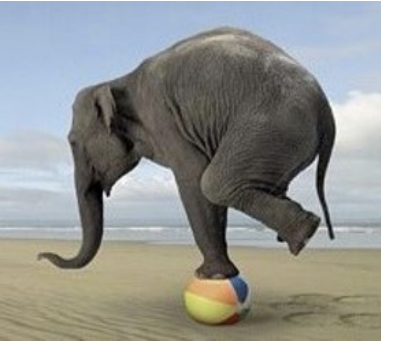 Looking in the various dictionaries for a definition of balance, one will find many different meanings. The most common would be ‘an even distribution of weight enabling something to remain upright or steady’ or ‘a state of equilibrium or condition in which different elements are equal or in the correct proportion’. So how do we apply either one of these definitions to the group of biological structures that comprise the horse’s foot? Veterinarians and farriers often use the term hoof balance to describe the theoretically “ideal” shape or conformation of a foot, the position of the hoof relative to the limb above, and how the foot should be trimmed; however, hoof balance lacks an intrinsic definition. Hoof balance should be considered a concept as there is no universal definition. Furthermore, it presents difficulty in communications between farriers and veterinarians and finally in relaying information to our clients. How often do we hear a veterinarian say, ‘please have the farrier balance this horse’s feet’ or the farrier may say, ‘I balanced this horse’s feet’? So, in either case, what does it really mean and where is the descriptive information? Another area of concern, especially for veterinarians, is keeping records and writing veterinary reports on either lameness or prepurchase examinations. If a veterinarian or farrier were to say in a report, ‘the horse’s feet need to be balanced’…this is not very descriptive information as to what needs to be changed. Looking in the various dictionaries for a definition of balance, one will find many different meanings. The most common would be ‘an even distribution of weight enabling something to remain upright or steady’ or ‘a state of equilibrium or condition in which different elements are equal or in the correct proportion’. So how do we apply either one of these definitions to the group of biological structures that comprise the horse’s foot? Veterinarians and farriers often use the term hoof balance to describe the theoretically “ideal” shape or conformation of a foot, the position of the hoof relative to the limb above, and how the foot should be trimmed; however, hoof balance lacks an intrinsic definition. Hoof balance should be considered a concept as there is no universal definition. Furthermore, it presents difficulty in communications between farriers and veterinarians and finally in relaying information to our clients. How often do we hear a veterinarian say, ‘please have the farrier balance this horse’s feet’ or the farrier may say, ‘I balanced this horse’s feet’? So, in either case, what does it really mean and where is the descriptive information? Another area of concern, especially for veterinarians, is keeping records and writing veterinary reports on either lameness or prepurchase examinations. If a veterinarian or farrier were to say in a report, ‘the horse’s feet need to be balanced’…this is not very descriptive information as to what needs to be changed. 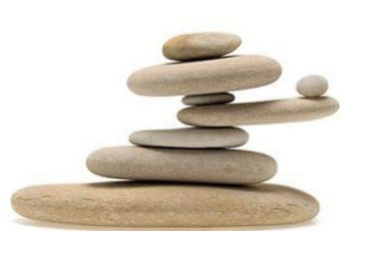 Hoof balance is further complicated as there are several categories of hoof balance such as static or geometric balance, dynamic balance, three-dimensional balance, and finally natural balance. Each one of these categories was proposed by an author for a given method of farriery and each method was thought to attain ‘overall’ balance. However, it would seem hard to satisfy all these types of hoof balance simultaneously. It would seem more reasonable to use repeatable landmarks on the foot or guidelines for trimming which could be applied to each individual foot. The guidelines that could be used are: Hoof balance is further complicated as there are several categories of hoof balance such as static or geometric balance, dynamic balance, three-dimensional balance, and finally natural balance. Each one of these categories was proposed by an author for a given method of farriery and each method was thought to attain ‘overall’ balance. However, it would seem hard to satisfy all these types of hoof balance simultaneously. It would seem more reasonable to use repeatable landmarks on the foot or guidelines for trimming which could be applied to each individual foot. The guidelines that could be used are:
For a more in-depth look at these trimming guidelines, the reader is referred here. The Hoof-pastern Axis 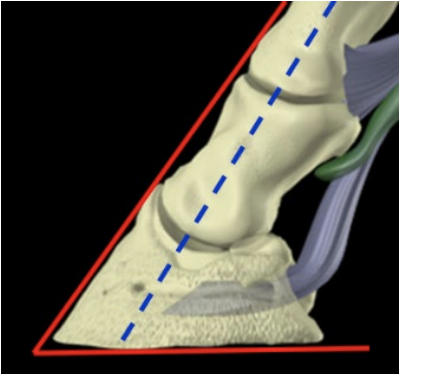 There are no scientific publications that validate the value of the hoof-pastern axis, but it is relatively easy to show the logic and biomechanical value of this perimeter. If we start with the digit, a straight alignment of the proximal, middle, and distal phalanx has the weight bearing borne efficiently through the center of each joint. Secondly, if the digit is straight, then the hoofpastern axis will generally be straight or parallel. Lastly and quite important; if the bony digit and the hoof-pastern axis is straight, then the solar surface of the distal phalanx will have a parallel relationship with the ground (see illustration above). There are no scientific publications that validate the value of the hoof-pastern axis, but it is relatively easy to show the logic and biomechanical value of this perimeter. If we start with the digit, a straight alignment of the proximal, middle, and distal phalanx has the weight bearing borne efficiently through the center of each joint. Secondly, if the digit is straight, then the hoofpastern axis will generally be straight or parallel. Lastly and quite important; if the bony digit and the hoof-pastern axis is straight, then the solar surface of the distal phalanx will have a parallel relationship with the ground (see illustration above). 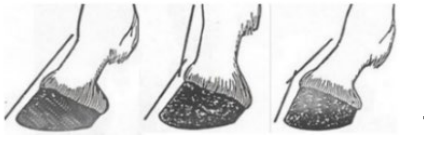 If the hoof-pastern axis (HPA) is not straight or parallel, the position of the distal interphalangeal joint changes and, therefore, the weight bearing function placed on the hoof capsule also changes. When the HPA is broken forward, it places the joint in flexion and shifts the weight to the toe section of the hoof capsule. If a broken back HPA is present, the joint is placed in dorsiflexion (extension) which shifts the load to the palmar section of the foot. Either HPA will change the weight bearing pattern placed on the joints which can alter performance and lead to lameness issues over time. Many farriers use a hoof gauge when trimming to check the angle of the dorsal hoof wall; however, this angle may not be useful as it only determines the angle of the individual foot but does not consider the angle of the hoof with the hoof’s relationship to the digit or the limb above. Dr. Olin Balch’s group stated in a 1999 study ‘The foot is trimmed and /or shod appropriately and the hoof angle is correct for the individual horse when the dorsal hoof wall and the dorsal surface of the pastern are parallel’. If the hoof-pastern axis (HPA) is not straight or parallel, the position of the distal interphalangeal joint changes and, therefore, the weight bearing function placed on the hoof capsule also changes. When the HPA is broken forward, it places the joint in flexion and shifts the weight to the toe section of the hoof capsule. If a broken back HPA is present, the joint is placed in dorsiflexion (extension) which shifts the load to the palmar section of the foot. Either HPA will change the weight bearing pattern placed on the joints which can alter performance and lead to lameness issues over time. Many farriers use a hoof gauge when trimming to check the angle of the dorsal hoof wall; however, this angle may not be useful as it only determines the angle of the individual foot but does not consider the angle of the hoof with the hoof’s relationship to the digit or the limb above. Dr. Olin Balch’s group stated in a 1999 study ‘The foot is trimmed and /or shod appropriately and the hoof angle is correct for the individual horse when the dorsal hoof wall and the dorsal surface of the pastern are parallel’. The Center of Rotation 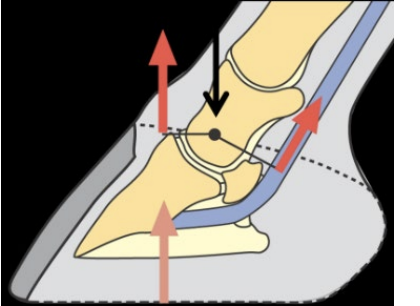 The second guideline or landmark used for trimming the foot is the center of rotation (COR). A vertical line drawn on a lateral radiograph from the center of the lateral condyle of the distal middle phalanx to the ground should bisect the bearing surface of the foot just palmar /plantar to the middle of the foot. This line demarcates the center of rotation of the DIP joint and should be in close proximity with a line drawn across the solar surface of the foot through the middle one-third of the frog or the widest part of the foot. The widest part of the foot is located 5-10 mm dorsal to the center of rotation and forms a landmark on the solar surface of the foot that is repeatable and can be used as a reference point when trimming. The widest part of the foot is also what farriers refer to as “Duckett’s bridge”. The widest part of the foot is the one point on the solar surface of the foot that remains relatively constant regardless of the shape or length of the ground surface that is dorsal or palmar to this point, i.e., the hoof capsule changes shape relative to the bone. In a biomechanical sense, the widest part of the foot is just dorsal to the center of rotation or the biomechanical pivot point which creates moments on either side of the COR. Therefore, when considering biomechanics, the distance and force (moment = distance x force) create a moment on each side of the line drawn through the widest part of the foot; these moments should approximate each other (equilibrium) when the horse is standing at rest (see figure above…black arrow is weight borne through the COR)). Following the trim, the ground surface of the ideal or biomechanically efficient foot should be as wide as it is long and the ground surface of the hoof capsule at the heels should not project dorsal to the base of the frog. The second guideline or landmark used for trimming the foot is the center of rotation (COR). A vertical line drawn on a lateral radiograph from the center of the lateral condyle of the distal middle phalanx to the ground should bisect the bearing surface of the foot just palmar /plantar to the middle of the foot. This line demarcates the center of rotation of the DIP joint and should be in close proximity with a line drawn across the solar surface of the foot through the middle one-third of the frog or the widest part of the foot. The widest part of the foot is located 5-10 mm dorsal to the center of rotation and forms a landmark on the solar surface of the foot that is repeatable and can be used as a reference point when trimming. The widest part of the foot is also what farriers refer to as “Duckett’s bridge”. The widest part of the foot is the one point on the solar surface of the foot that remains relatively constant regardless of the shape or length of the ground surface that is dorsal or palmar to this point, i.e., the hoof capsule changes shape relative to the bone. In a biomechanical sense, the widest part of the foot is just dorsal to the center of rotation or the biomechanical pivot point which creates moments on either side of the COR. Therefore, when considering biomechanics, the distance and force (moment = distance x force) create a moment on each side of the line drawn through the widest part of the foot; these moments should approximate each other (equilibrium) when the horse is standing at rest (see figure above…black arrow is weight borne through the COR)). Following the trim, the ground surface of the ideal or biomechanically efficient foot should be as wide as it is long and the ground surface of the hoof capsule at the heels should not project dorsal to the base of the frog. Heels Trimmed to The Base of The Frog 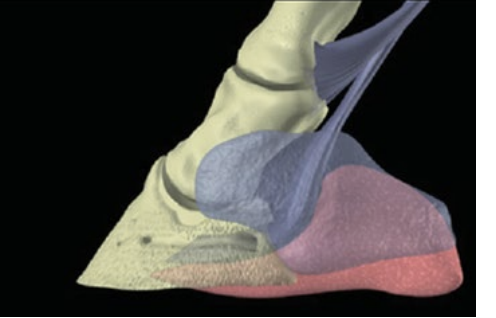 The third guideline is the heels of the hoof capsule extending to the base of the frog. Located within the hoof capsule dorsally are osseous structures that accept load through the lamellae interface and the soft tissue structures palmarly/plantarly that are thought to absorb concussion during load bearing and dissipate the energy of impact. Within the hoof capsule, the distal phalanx occupies approximately two-thirds of the space, and the soft tissue structures occupy one-third. For effective physiologic functioning of the foot, the osseous and soft tissue structures must be located on the same plane within the hoof capsule and complement each other during weight bearing. To achieve this structural relationship, the hoof wall at the heels of the hoof capsule should extend to or approximate the base of the frog. Appropriate or consistent trimming of the palmar/ plantar section of the foot has always presented problems for the farrier, for a variety of reasons. Variations in hoof conformation, farrier training, empiric considerations, and owner pressure on the farrier not to trim the heels often dictate how the heels are trimmed. If the heels are not trimmed appropriately and allowed to migrate dorsally toward the center of the foot, the laminar interface and the bones of the digit assume the function of the soft tissue structures. Occasionally, the heels of the hoof capsule can’t be trimmed to the base of the frog for anatomical reasons, but an attempt should always be made to do so. If the hoof wall at the heels cannot be trimmed to the base of the frog, the branches of the shoe or some other form of farriery can be used to extend the ground surface of the hoof capsule to the base of the frog. I would personally like to remove the term ‘lower the heels’ from the farrier language and replace it with ‘trim the heels to increase the ground surface”. Trimming the heels to the base of the frog increases the solar surface of the foot and improves the hoof-pastern axis. This improvement can readily be observed using a before and after lateral radiograph. The third guideline is the heels of the hoof capsule extending to the base of the frog. Located within the hoof capsule dorsally are osseous structures that accept load through the lamellae interface and the soft tissue structures palmarly/plantarly that are thought to absorb concussion during load bearing and dissipate the energy of impact. Within the hoof capsule, the distal phalanx occupies approximately two-thirds of the space, and the soft tissue structures occupy one-third. For effective physiologic functioning of the foot, the osseous and soft tissue structures must be located on the same plane within the hoof capsule and complement each other during weight bearing. To achieve this structural relationship, the hoof wall at the heels of the hoof capsule should extend to or approximate the base of the frog. Appropriate or consistent trimming of the palmar/ plantar section of the foot has always presented problems for the farrier, for a variety of reasons. Variations in hoof conformation, farrier training, empiric considerations, and owner pressure on the farrier not to trim the heels often dictate how the heels are trimmed. If the heels are not trimmed appropriately and allowed to migrate dorsally toward the center of the foot, the laminar interface and the bones of the digit assume the function of the soft tissue structures. Occasionally, the heels of the hoof capsule can’t be trimmed to the base of the frog for anatomical reasons, but an attempt should always be made to do so. If the hoof wall at the heels cannot be trimmed to the base of the frog, the branches of the shoe or some other form of farriery can be used to extend the ground surface of the hoof capsule to the base of the frog. I would personally like to remove the term ‘lower the heels’ from the farrier language and replace it with ‘trim the heels to increase the ground surface”. Trimming the heels to the base of the frog increases the solar surface of the foot and improves the hoof-pastern axis. This improvement can readily be observed using a before and after lateral radiograph. Hoof balance is the traditional term to describe the many aspects of farriery and is not likely to change. However, a more effective option may be to use a set of biomechanical principles or landmarks that can be used as guidelines which have a universal meaning that can be applied to every horse, allowing the individual foot to be evaluated, trimmed, and/or shod in a consistent, reproducible manner (Figure 1).These guidelines standardize the basic approach to farriery for both farriers and veterinarians. Furthermore, they do not interfere with nor contradict the traditional concepts of static, geometric, dynamic, or natural balance. The guidelines can also be used to modify existing hoof conformation, correct hoof capsule distortions and improve the landing patterns of the foot.
Be Safe |